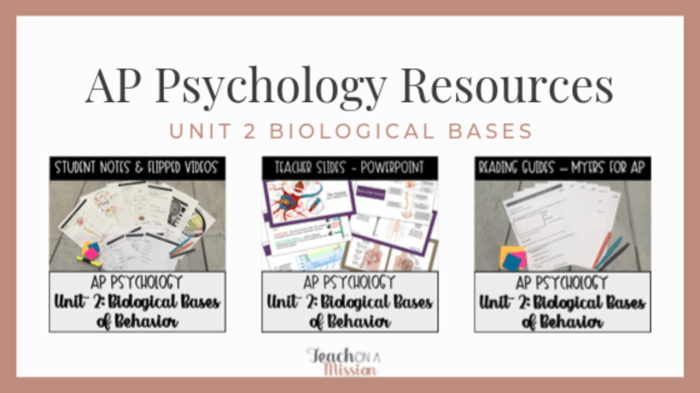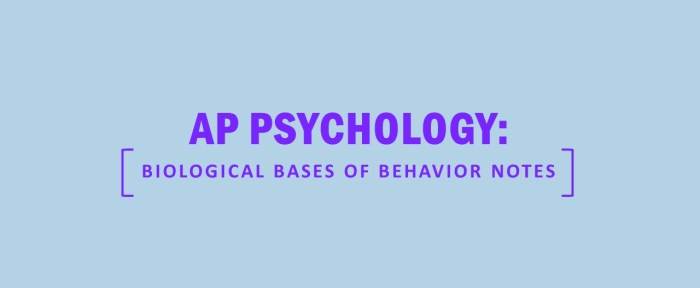Ap psychology unit 3 biological bases of behavior – Embarking on AP Psychology Unit 3: Biological Bases of Behavior, we delve into the intricate relationship between biology and behavior. This exploration unveils the fundamental principles that govern our thoughts, emotions, and actions, providing a deeper understanding of human nature.
Delving into the realm of neuroscience, we dissect the structure and function of neurons, the building blocks of the nervous system. We uncover the diverse roles of neurotransmitters in facilitating communication within the brain. Additionally, we investigate the organization and functions of the nervous system, exploring the intricate interplay between the central and peripheral nervous systems.
Neurons and Neurotransmitters: Ap Psychology Unit 3 Biological Bases Of Behavior

The nervous system is composed of billions of neurons, which are specialized cells that transmit information throughout the body. Neurons have a cell body, dendrites, and an axon. The cell body contains the nucleus and other organelles. Dendrites are short, branched extensions of the cell body that receive signals from other neurons.
The axon is a long, slender extension of the cell body that transmits signals to other neurons or muscles.
Neurons communicate with each other through neurotransmitters, which are chemical messengers that are released from the axon terminal of one neuron and bind to receptors on the dendrites of another neuron. There are many different types of neurotransmitters, each with its own unique function.
Some of the most important neurotransmitters include:
- Acetylcholine (ACh): ACh is involved in a variety of functions, including muscle contraction, memory, and attention.
- Dopamine (DA): DA is involved in reward, motivation, and movement.
- Epinephrine (EPI): EPI is involved in the body’s response to stress.
- GABA (gamma-aminobutyric acid): GABA is involved in inhibition, which is the process of preventing neurons from firing.
- Glutamate: Glutamate is the most common excitatory neurotransmitter in the brain.
- Serotonin (5-HT): 5-HT is involved in mood, sleep, and appetite.
The following table compares and contrasts the major neurotransmitters:
| Neurotransmitter | Function |
|---|---|
| Acetylcholine (ACh) | Muscle contraction, memory, attention |
| Dopamine (DA) | Reward, motivation, movement |
| Epinephrine (EPI) | Body’s response to stress |
| GABA (gamma-aminobutyric acid) | Inhibition |
| Glutamate | Excitatory |
| Serotonin (5-HT) | Mood, sleep, appetite |
Nervous System

The nervous system is divided into two main parts: the central nervous system (CNS) and the peripheral nervous system (PNS). The CNS consists of the brain and spinal cord. The PNS consists of all the nerves that connect the CNS to the rest of the body.
The CNS is responsible for processing information and controlling the body’s movements. The brain is the center of the CNS. It is responsible for higher-level functions such as thinking, learning, and memory. The spinal cord is responsible for transmitting messages between the brain and the rest of the body.
The PNS is responsible for transmitting messages between the CNS and the rest of the body. The PNS is divided into two parts: the somatic nervous system and the autonomic nervous system.
The somatic nervous system is responsible for voluntary movements. The autonomic nervous system is responsible for involuntary functions such as breathing, digestion, and heart rate.
The brain is divided into several major divisions, each with its own unique functions. The major divisions of the brain include:
- Cerebrum: The cerebrum is the largest part of the brain. It is responsible for higher-level functions such as thinking, learning, and memory.
- Cerebellum: The cerebellum is responsible for coordination and balance.
- Brainstem: The brainstem is responsible for vital functions such as breathing, heart rate, and sleep.
Endocrine System
The endocrine system is a network of glands that secrete hormones into the bloodstream. Hormones are chemical messengers that travel throughout the body and affect the activity of cells and organs.
The endocrine system plays a vital role in regulating a wide range of bodily functions, including metabolism, growth, reproduction, and mood.
Some of the most important hormones include:
- Insulin: Insulin is produced by the pancreas and helps to regulate blood sugar levels.
- Thyroid hormone: Thyroid hormone is produced by the thyroid gland and helps to regulate metabolism.
- Estrogen: Estrogen is produced by the ovaries and helps to regulate the menstrual cycle and pregnancy.
- Testosterone: Testosterone is produced by the testes and helps to regulate muscle growth and sex drive.
- Cortisol: Cortisol is produced by the adrenal glands and helps to regulate the body’s response to stress.
The following diagram illustrates the feedback loops involved in hormone regulation:

Genetics and Behavior

Genetics play a significant role in behavior. Genes are units of heredity that are passed down from parents to offspring. Genes influence a wide range of traits, including physical appearance, personality, and intelligence.
There are several different methods used to study the genetic basis of behavior. One method is family studies. Family studies compare the behavior of family members to identify patterns of inheritance.
Another method is twin studies. Twin studies compare the behavior of identical twins (who share 100% of their genes) and fraternal twins (who share only 50% of their genes). If identical twins are more similar in behavior than fraternal twins, this suggests that genes play a role in that behavior.
There are many examples of how genetic factors can influence behavior. For example, genes have been linked to aggression, anxiety, and depression.
Evolutionary Psychology
Evolutionary psychology is the study of how evolution has shaped human behavior. Evolutionary psychologists believe that many of our behaviors are the result of adaptations that evolved over time to help our ancestors survive and reproduce.
One of the basic principles of evolutionary psychology is that natural selection favors traits that increase an organism’s chances of survival and reproduction. This means that traits that help us to find food, attract mates, and avoid predators are more likely to be passed down to our offspring.
Evolutionary psychology can help us to understand a wide range of human behaviors, including aggression, altruism, and mate selection.
Here are some examples of how evolutionary forces have shaped human behavior:
- Humans are social creatures because cooperation was essential for survival in our ancestral environment.
- Humans are attracted to certain physical features because these features are associated with health and fertility.
- Humans are aggressive because aggression can help us to obtain resources and defend ourselves from threats.
FAQ Explained
What is the role of neurotransmitters in communication?
Neurotransmitters are chemical messengers that facilitate communication between neurons. They are released from the presynaptic neuron and bind to receptors on the postsynaptic neuron, triggering a response.
How does the endocrine system influence behavior?
The endocrine system secretes hormones that regulate various bodily functions, including behavior. Hormones can affect mood, motivation, and social interactions.
What is the role of genetics in behavior?
Genetics plays a significant role in shaping behavior. Genes influence our physical characteristics, personality traits, and susceptibility to certain disorders.